Kaishi and Kuromoji
An essential utensil used by the guest at a Tea gathering is a pack of kai-shi, 懐紙, heart-paper, consisting of a taba, 束, ream, of thirty sheets of paper folded in half which makes sixty layers. The present kaishi originated in the kami kama-shiki, 紙釜敷, paper kettle-spread, which Rikyū had cut in half. Kaishi are available in different sizes for women and men: women’s kaishi measures 4.8 x 5.8 sun kane-jaku, and men’s kaishi measures 5.8 x 6.8 sun kane-jaku. The sheets of paper are folded in half to keep them organized, otherwise they would be awkward to handle as flat sheets. Thus, one may think of the kaishi as always being folded in half, however, it should be understood that the important measurement is the full size of a single sheet of kaishi.
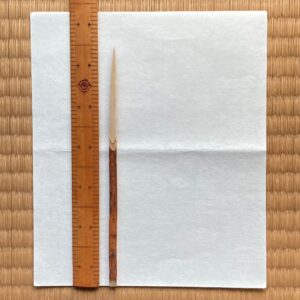
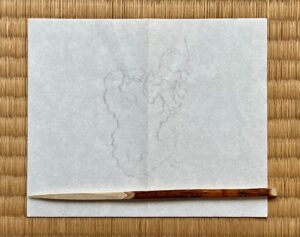
Women’s kaishi measures 4.8 x 5.8 sun kane-jaku. The length of 5.8 sun kane-jaku is the same as the width of men’s kaishi. The number 8 is symbolic of Infinity in Space. The diagonal measurement is 7.5 sun kane-jaku or 6 sun kujira-jaku. The number 6 is symbolic Infinity in Time. ‘Infinity’ in Japanese is mu-gen, 無限, no-limit. The folded pack of kaishi consists of sixty layers, and in Japanese culture at the age of sixty, one celebrates their kan-reki, 還暦, return-calendar. The kanreki is a metaphorical return to a new beginning.
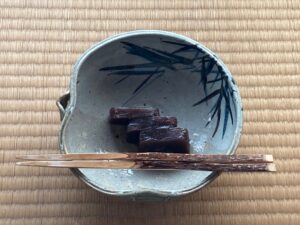
The pack of kaishi is used to temporarily hold sweets eaten before drinking the tea. The sweet, omo-ga-shi, 主菓子, principal-sweet-of, is a relatively large and moist sweet that is usually served before drinking koi-cha, 濃茶, thick-tea, and it is this sweet in particular that is eaten with a pick called kuro-mo-ji, 黒文字, black-character-letter.
The branch of kuromoji, Lindera umbellate Thunb., is an herbal medicine called ‘u-shō’, 烏樟, crow-camphor, Cinnamomum camphora. According to the Japanese and Chinese Dictionary of Medicines, it has effects on the symptoms of the digestive system such as sunstroke, colicky pain, abdominal pain, abdominal bloating and undigested food retention. As an aromatic plant containing plenty of volatile components such as linalool and geraniol, it has been used as a toothpick since ancient times, and its essential oil has been used for aromatherapy.
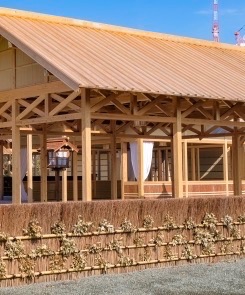
Kuro-mo-ji shiba-gaki, 黒文字 柴垣, black-letter-character brushwood-fence, at Dai-jō-kyū, 大嘗宮, Great-former-palace. The shrine consisting of thirty buildings was temporarily constructed on the grounds of the imperial palace for sacred ceremonies, the ascension to the throne by the Emperor Naru-hito, 徳仁, Virtue-benevolence, and the beginning of the Rei-wa,令和, Decree-peace, era in Japan. After the ceremonies the entire construction was dismantled.
Sacred grounds are often protected by shiba-gaki, 柴垣, brushwood-fences, and one such plant is Kuromoji. The word kuromoji is a common name for Ten-dai U-yaku, 天台烏薬, Heaven-support Crow-medicine, that originated in southern China. The Japanese Buddhist monk, Sai-chō, 最澄, Most-clear, (766), studied there during the Tang period. Kuromoji grows wild in various parts of Japan. It is said that it was named because its ju–hi, 樹皮, tree-bark, has a pattern like kuromoji.
Saichō was credited with founding the Ten-dai, 天台, Heaven-support, sect in Japan, founded the temple and headquarters of Tendai at En-ryaku-ji, 延暦寺, Lengthen-calendar-temple, on Hi-ei-zan, 比叡山, Compare-intelligence-mountain, northeast of Kyōto. He is also said to have been the first to bring tea to Japan. After his death, he was awarded the posthumous title of Den-gyō Dai-shi, 伝教大師, Transmit-faith Great-master.
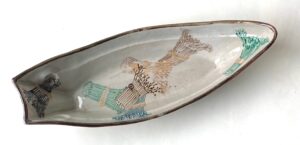
‘Shiba-fune’, 柴舟, Brushwood-boat, is the name of an incense blend of neri-kō, 練香, knead-incense, created by Tan-tan-sai, 淡々斎, Light-light-abstain, XIV Iemoto, Urasenke. Nerikō is customarily used with the ro.
Although stick incense, sen-kō, 線香, is not traditionally burned for a Tea gathering, Buddhists burn incense every day for Zen meditation and prayer. Many renowned Buddhist temples sell sen-kō, 線香, stick-incense, that is burned in the temple. Enryakuji sells an incense, kun-kō, 薫香, fragrant-incense, at one of its sub-temples, An-raku Ritsu-in, 安楽律院, Peace-pleasure Law-institute: stick length is 4.5 sun kane-jaku.
In Chanoyu, the kuromji sweet pick is made of a shrub named kuromoji, Lindera umbellata, which lends its name to the pick. A single stick is used to cut and spear the sweet, and the kuromoji’s standard length, perhaps even required, is 6 sun kane-jaku. The handle end of the pick maintains the bark of the shrub, and is cut to be of square section with sharp edges to cut the food, and pared to a point, like a spear. Note that the barked handle end is approximately the same measurement as half the length of the full sheet of men’s kaishi.
The omogashi is also called a nama-ga-shi, 生菓子, raw-sweet, which, when eaten makes no noticeable sound. Some Japanese sweets such as raku-gan, 落雁, alight-geese, that are served with usu-cha, 薄茶, thin-tea, can be crunchy and make noise. Perhaps it is essential that the namagashi eaten before drinking koicha because it can be eaten while maintaining silence.
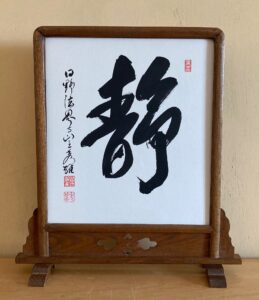
According to Japanese symbolism, the number 8, hachi, 八, is symbolic of Infinity in Space, which is found in the measurements of both kinds of kaishi. The number 6, roku, 六, is symbolic of Infinity in Time. The length of the kuromoji is 6 sun kane-jaku, and the full length of men’s kaishi is 6.8 sun kane-jaku. They relate to each other 6 : 6.8 or 3 : 3.4. – and 10 : .8823529. Perhaps the number could be shortened to .88, hachi-jū-hachi, 八十八, eight-ten-eight, which is highly symbolic of Infinity in Space. In Buddhism, human beings have eighty-eight worldly desires that must be dispelled.
The Kanji, 八十八, can be written to create the Kanji for rice, kome, 米, which is symbolic of the center of the world. Customarily, a guest at a Tea gathering often carries their own pick called a yō-ji, 楊枝, willow-twig, of a knife-like kashi-kiri, 菓子切, sweet-of-cut, made of metal or other sharp material. However, it is correct, perhaps imperative, to use the kuromoji offered by the teishu, with the kaishi to eat the sweet.
The kaishi may be symbolic of the thirty chapters of the Heart Sutra, Han-nya-shin-gyō, 般若心経, Carry-young-heart-sutra. It may be no coincidence that the kaishi is called heart-paper. Also, when wearing kimono, the pack of kaishi is held in the front overlapping of the kimono: in men’s kimono the kaishi is held near the belly, whereas in women’s kimono, the kaishi is held near the heart.

The number 88 and the Heart Sutra are interconnected with the pilgrimage to the eighty-eight Buddhist temples on Shi-koku, 四国, Four-states: Hachi-jū-ha-kka-sho-meguri, 八十八ヶ所巡り, Eight-ten-eight ’s place- circumambulation. The locations were established by the founder of Shin-gon-shū, 真言宗, True-vow-sect, of Buddhism, Kō-bō Dai-shi, 弘法大師, Wide-law Great-master, also called Kū-kai, 空海, Empty-sea, (774 – 835). Pilgrims, hen-ro, 遍路, general-way, walk the route over a period of days, while reading or contemplating the Heart Sutra espoused by Kūkai, so that worldly desires will disappear, and wishes will come true. A book, which may contain the Heart Sutra, or a formatted paper or fabric hanging scroll is carried along the route to be stamped and signed at each of the 88 temples.
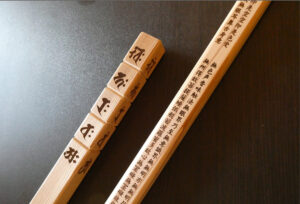
This image above shows parts of the kongōzue, such as the full staff as pictured above. The Sanskrit characters could be called moji in Japanese, and the characters on the kongōzue are black ink. This could be seen as kuro-moji, black-characters.
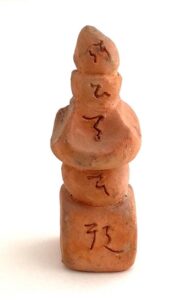
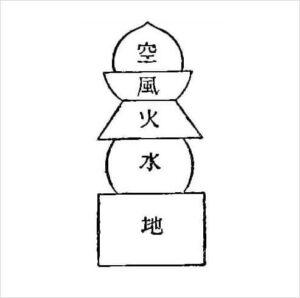
The five Sanskrit, Bon-go, 梵語, Brahman-language, characters are emblematic of the elements that can be associated with chakras, centers of the human body. The elements are Earth, Water, Fire, Air, and Space, and their individual sounds when spoken are, in the same order, lam, vam, ram, yam, ham.
Each pilgrim, hen-ro, 遍路, wide-way, usually has the aid of a walking-stick called a kon-gō-zue, 金剛杖, gold-strength-staff. Lengths vary according to size of a person, although a standard is about 5 shaku kane-jaku. The kongōzue, also called the vajra stick, is made off various woods including tsuga, 栂, Japanese hemlock, sugi, 杉, cedar, hinoki, 桧, cypress, etc. The stick is usually of square section with chamfered corners that constitute eight-sides, as 8 is the number of Infinity in Space. It also has a fabric cover for the handle end, with a small suzu, 鈴, bell, attached. The staff may be inscribed bearing the name of Kōbō Daishi. Some sticks may be carved to resemble a Go-rin-tō, 五輪塔, Five-ring-tower, which is symbolic of the immortal soul, and some have the Heart Sutra written or printed on the four sides.
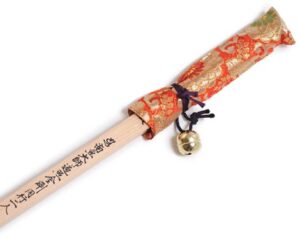
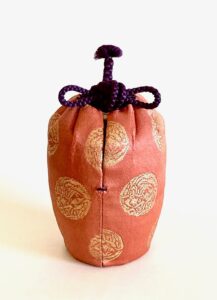
Left: kongōzue with cover of gold brocade covering the five Sanskrit characters, with small suzu, 鈴, bell. Right: shi-fuku, 仕覆, serve-cover, wrapping a ceramic chaire, silk fabric with a pattern of double ‘phoenixes’ called, ‘futari shizuka’ kin-ran, 二人静金襴, two-person quiet gold-brocade; H. to top of tassel end of the cord knot, uchi-dome, 打留, end-stop, 3.8 sun kane-jaku.
Suzu, 鈴, bell attached to the kin-ran, 金襴, gold-brocade, tsue kaba-, 杖カバー, staff cover: L. 6 sun kujira-jaku. The fabric covers the handle end of the staff to protect the five Sanskrit characters, rather like a shi-fuku, 仕覆, serve-cover, covers a cha-ire, 茶入, tea-receptacle. There is an interesting connection between the kin-ran, 金襴, gold-brocade, cover of the kon-gō-zue, 金剛杖, gold-strength-staff, as both words contain the Kanji for gold, 金, which is read kin , kon, and kana. There is another connection between the kongōzue cover and shifuku, because the Kanji for shi-fuku, 仕覆, fuku means inverted, and the cover of the kongōzue is inverted on the staff.
It may be that the purpose of the kongōzue fabric cover is to protect the Sanskrit characters of the Gorintō, just as the shifuku of the chaire, is protection to protect the jar and the contents, and identifies them with the Gorintō. The chaire may have more than five discernible rings, which could be identified with the other numbers of chakras.
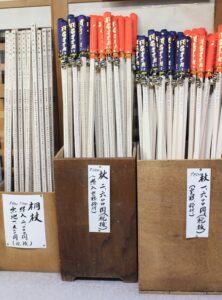
The henro kongō-zue may be likened to the shaku-jō, 錫杖, tin-staff. When allied with Chanoyu, it would be more like Sen no Rikyū’s walking stick called a ro-ji zue, 路地杖, dew-ground staff. The roji-zue is made of bamboo that has nana fushi, 七節, seven nodes, which creates six chambers, roku kan, 六間, six-intervals. The length of the bamboo is san shaku, 三尺, yon sun, 四寸, go bu, 五分, [approximately 40 inches]. The ‘san–shi–go’, 三四五, Three-four-five, is a standard Japanese tool to form right angles: a wood or metal triangle, called an ō–gane, 大矩, large-carpenter’s square. It is comprised of three lengths of 3, 4, and 5.

Shaku-jō, 錫杖, tin-staff, brass with turned wooden shaft.
The shakujō is believed to have been created by Kashapa, a follower of the Buddha. The staff has a metal hoop finial with six free-hanging rings, three on each side. Each of the six rings is identified with one of the Roku–dō, 六道, Six-ways, where Jizō is guardian in each of the six realms.
A shakujō is carried by Jizō Bosatsu, Senjū Kannon Bosatsu and Jūichimen Kannon Bosatsu. The long wooden staff is also used by Jizō to measure the depth of the San-zu-no-gawa, 三途川, Three-crossing-river, that souls must cross to enter paradise.
The six rings, roku-kan, mutsu-kan, 六鐶, six-(metal)rings, refer to the six realms of existence that are protected by Jizō. These six realms are called the roku-dō, 六道, six-ways, which refers to hell at the bottom and heaven on top. They also are identified with the six perfections that lead to nirvana: generosity, morality, patience, vigor, concentration, and wisdom. The rings are divided so that there are three rings on either side of the central element. This arrangement may be simply for balance and symmetry or there could be some symbolic significance.
The six realms from the bottom are called the Three Evil Paths, and are hell, hungry ghosts, and animals. Above these are the states of ashura (demi-gods), humans, and tenbu (gods). The six rings may also be identified with the six-syllable mantra of Kannon Bosatsu: Jizō is devoted to Kannon: om ma-ni pad-me hum, [o] jewel in the lotus [m].
Rikyū’s roji-zue is bamboo and round, whereas the henro kongō-zue is wood and of square section.
Reverence to Jizō is found in the recitation of the Heart Sutra. In Japan, there are commemorative coins that have the Heart Sutra on one side with the image of Jizō, or other deity, on the other side. They are not currency, but a way to carry the spirit of Jizō and the sutra on one’s person.
The pick called kuro-mo-ji, 黒文字 , black-letter-character, may refer to mo-ji, 文字, letter-character, written in black, kuro, 黒, ink, sumi, 墨. Perhaps this is a reference to the five Sanskrit characters written on the henro kongō-zue.
![]()
In the course of a full Chaji, 茶事, Tea-matter, the event is divided into two parts: sho-iri, 初入り, first-entry, or sho-za, 初座, first-sit, and go-iri, 後入り, latter-entry, or go-za, 後座, latter-sit. During the shoza, a meal called kai-seki, 懐石 , heart-stone, is served, and is followed by serving an omogashi. The Kanji for the word seki, 石, stone, in kaiseki, 懐石, refers to a Buddhist custom of heating a stone, wrapping it in a towel, and placing it in the kimono near the stomach to ward off hunger pangs. Food in a Chaji should be just enough to appease hunger, and not a grand array of special treats.
Following the meal, sweets are offered to the guests in a stack of individual boxes called a fuchi-daka, 縁高, edge-high, with a single kuromoji pick on the lid of the box for each guest. After eating the sweet on the kaishi with the kuromoji, the guest takes the pick as a souvenir, o-miage, お土産, hon.-earth-product, and slips it into the pack of kaishi. The pack of kaishi is returned to the front of the kimono, which is the place where a Buddhist would carry a booklet containing the Heart Sutra. The Heart Sutra has been created in many media and often as part of a bracelet.
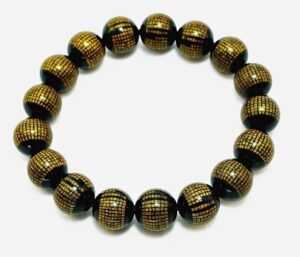
Buddhists often have juzu, 数珠, number-jewel, a string of beads similar to a rosary. Juzu are used to keep count of invocations and prayers, while others are carried or worn for protection and spiritual comfort. Bracelets of beads made of stone or precious wood are made with images, Sanskrit characters, spiritual texts. Some have the text of the Heart Sutra.

After having the sweet, the guests leave the Tearoom, and return to the roji, 露地, dew-ground. to freshen up, in a recess called naka–dachi, 中立, middle-standing. Upon hearing the sound of a gong in the daytime or bell at night, from inside the Tearoom, the guests revisit the tsukubai to purify the hands and mouth, and return to the Tearoom to have koicha followed by usucha.
The kuromoji is a gift of the tei-shu, 亭主, house-master, for the guests to have the pick as a kind of kongō-zue to accompany them on their way through the roji to the outer roji, and ultimately to re-enter the Tearoom fortified by the walk, which is a kind of pilgrimage to enlightenment. The Kanji for ro, 露, dew, of ro-ji, 露地, dew-ground, also means enlightenment in Buddhism.

One might wonder why the length of the preferred kuromoji pick is six sun kane-jaku. Perhaps there is a connection with aspects of Buddhism, as the familiar yō-ji, 柳枝, willow-stick, made of willow wood, is one of the essential tools that a Buddhist can own.
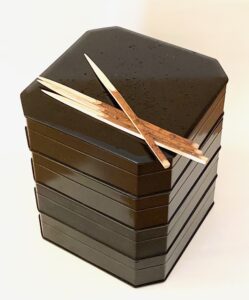
The lid is sprinkled with ‘tsuyu’, 露, ‘dew’, which is done in the warm half of the year, and is to give a feeling of freshness and symbolic of enlightenment and mortality. It may be that the dew on the fuchidaka, with the dampened kuromoji, is related to the dew of the roji garden of enlightenment with the kuromoji in the kaishi placed near the heart.
The omo-ga-shi, 主菓子, main-sweet-of, is presented to the guest in several different ways; individually on a dish, wood board, sheets of paper, or in a fuchidaka. The fuchidaka may be presented with a single sweet in individual boxes that are stacked one upon the other. The sweet in a box is borrowed directly from Buddhism, and can be used to serve food. The most familiar box is essentially square with mitered corners, and lacquered black. Its eight sides are symbolic of Infinity in Space. Together, the box with a kuromoji for each guest, combines the numbers eight and six, symbolic of Inifinity in Time and Space. The box is meticulously crafted by skilled artists, whereas the kuromoji is a simply cut natural wooden stick.
The number six is symbolic of Infinity in Time, is identified with Water, and is the culmination of the Go-rin, 五輪, Five-rings, five principles: Earth, Water, Fire, Wind, and Void, which are consummated in Shiki, 識, Consciousness, Sanskrit Vijnana. The number six is associated with many things in Japanese culture. The Go-rin, 五輪, Five-principles, of Buddhism and Hinduism, culminates in a sixth principle of Shiki, 識, Consciousness. Also in Buddhism is the Roku-dō, 六道, Six-ways.
The Buddhist Roku-dō, 六道, Six-ways, are the six realms of human desire. Ji-goku–dō, 地獄道, Earth-prison-way; Ga-ki-dō, 餓鬼道, Hungry-ghost-way; Chiku-shō-dō, 畜生道, Animal-life-way; A-shu-ra-dō, 阿修羅道, Praise-conduct-spread-way, Demi-gods; Nin-dō, 人道, Person-way; Ten-dō, 天道, Heaven (deva)-way.
Other aspects of the number six are the Roku-do-man-gyō, 六度万行, Six-degrees-ten thousand-transition, is an aspect of Roku-ha-ra-mitsu, 六波羅蜜, Six-degrees-spread-honey, preached by the Buddha in his forty-five years of teaching. The following is a list of the Roku-do Man-gyō, 六度万行, Six-degrees Ten-transition, of the body.
- Fu-sei, 布施, Distribute-alms, Charity.
- Ji-kai, 持戒, Hold-commandments, Adherence to Buddhist precepts.
- Nin-niku, 忍辱, Endure-shame, Forbearance.
- Shō-jin, 精進, Spirit-advance, Devotion.
- Zen-jō, 禅定, Meditation禅定, Meditation-determine, Concentration.
- Chi-e, 智慧, Intellect-wise, Wisdom.
One of the varieties of kon-gō-sho, 金剛杵, gold-strength-pestle, is the to-kko-sho, 独鈷杵, single-cobalt-pestle, which is a single metal spear that has a single blade or blade at both ends.
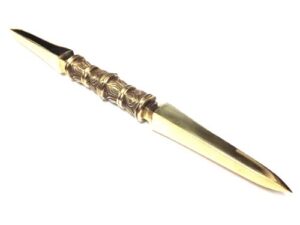
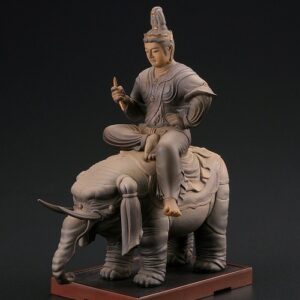
Left: to-kko-sho, 独鈷杵, single-cobalt-pestle, polished bronze. Right: image of Tai-shaku-ten, 帝釈天, Emperor-explain-heaven (deva), seated on the white elephant, Airavata; 9th century treasure of Tō-ji, 東寺, East-temple, Kyōto. Taishakuten is the Japanese name for Indra, the Vedic king of the gods, and who holds in his right hand a tokkosho, which is symbolic of a lightning bolt. The tokkosho of Taishakuten may be likened to the kuromoji.
In the beginning, it is believed that a lightning bolt struck pregnant waters, and life came into existence. Water is essential for life and growth. The omo-gashi is moist, so that perhaps the kuromoji divides the sweet, just as Taishakuten’s lightning bolt divided the curtain of ignorance, that was deified as Vritra, Indra’s mortal enemy. One of most familiar sweets served as omogashi, is a kind of mochi, which is sweetened bean an, 餡, covered in gyū-hi, 求肥, wish-fertile, soft mochi-like covering.
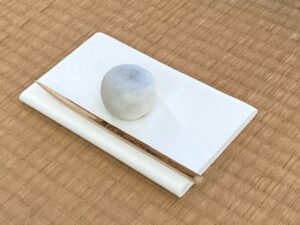
For further study, see also: Sensu, Jizō Bon, and Kamashiki and Kamasue

